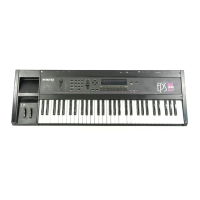EPS-16 PLUS Musician's Manual Section 5 — Sampling
Aliasing
A digital sampler can only accurately record frequencies up to one half that of the
sample rate. This frequency (half the sample rate) is known as the Nyquist
frequency, after the fellow who figured that out. Trying to sample sounds that
contain frequencies above half the sample rate will result in aliasing, the creation
of false (or "alias") low-frequency tones, when playing the sound back.
Suppose we were to sample the wave from our previous example at a much lower
sample rate (fewer times per second), like this:
When the EPS-16 PLUS tries to reproduce this sound (to connect the dots, as it
were) the resulting wave bears litle resemblance to the original, because there are
not enough sample points to accurately recreate it:
To prevent aliasing, the EPS-16 PLUS has a variable input (or "anti-aliasing")
filter which removes frequencies above a cutoff point before the signal reaches the
sampling circuitry. Whenever you change the sample rate, the EPS-16 PLUS
automatically adjusts its input filter to the highest suitable cutoff frequency for that
rate. You can, however, change it manually if you want a higher or lower
setting. (From the sample rate parameter, scroll right to select FILTER CUTOFF
=###.)
Aliasing 5 - 3

